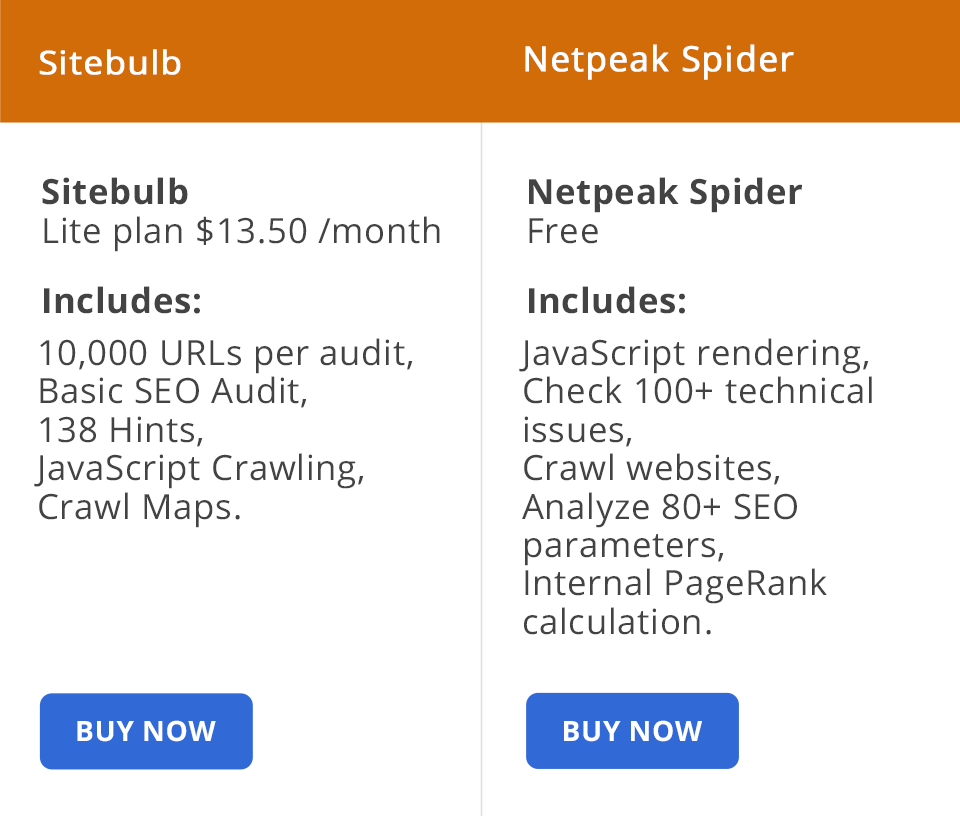
Whether you are a freelancer or work for a SEO company, you need to use technical tools for accurate site analysis. If you can’t choose between Sitebulb vs Netpeak Spider, make sure to learn more about their key features.
Apart from being a desktop SEO crawler, Sitebulb provides a wide array of other helpful options. It analyses your site and generates practical recommendations and appealing visualizations. This tool will save you plenty of time and improve your technical SEO audits.
Netpeak Spider is a desktop program that will quickly audit your website. A 3.0 version allows you to work with big sites and perform complex SEO analysis in no time.

Sitebulb can bring your site or web page to the top of searches. It is a desktop program developed for search engine optimization. Sitebulb works smoothly with Windows and Mac. Combine a Sitebulb crawling program with network monitoring tools and you will greatly improve your technical SEO audits. It will save you plenty of time.
This program offers intuitive visualizations to help you handle deep-rooted challenges and more effectively cooperate with your colleagues to achieve the desired results. It has crawl maps, search traffic, indexing, keyword positioning features and more.


Netpeak Spider is developed to detect any SEO issues that affect your website’s visibility. Netpeak analyses website pages and their attributes and detects all existent SEO problems that directly influence the popularity of your site.
Netpeak Spider is a great choice for owners and developers who value their time. It can quickly perform a technical audit of a website and guarantees that your website will be accessible to your target audience. Mind that you need to create a personal account to use Netpeak Spider.


It’s time to look closely at Netpeak and Sitebulb pricing. Sitebulb offers a Standard Plan for $13.50 per month per user. You will have to pay $7 for every additional license. It is an appealing offer for freelancers, startups, website owners and web agencies. There is also a Pro Plan available. It costs $35 per month. It is an ideal solution for SEO professionals, consultants and digital marketing agencies.
Netpeak Spider offers basic features for free. However, you may still get some paid plans if necessary. A Standard Plan costs $19 a month, a Pro Plan costs $39, and a Premium one costs $99.
If you plan to use it for a long time, you may buy a one-year license and get a 20% discount. If you choose the Standard Plan, you won’t get the multi-domain crawling feature and won’t be able to contact customer support. These options are available within Pro and Premium plans.
When comparing Sitebulb vs Netpeak Spider, you will see that they serve the common goal and are designed to work with SEO tools. They are perfect for scanning sites, searching for mistakes (broken links, wrong redirects, duplexing, title, keywords and description), analyzing inbound and outbound internal links for each page and strengthening Internet security.
Both programs offer similar functions and possibilities so what should you choose? Here, everything depends on your personal preferences. Sitebulb and Netpeak Spider have free trial versions so you can test them and find an optimal solution for your needs. You don’t even have to enter your payment details.
Sitebulb positions itself as one of the most effective reporting systems on the market. It helps hundreds of users deeply analyze data and bring their websites to a new level. Besides, it has a conveniently-organized audit overview panel that allows you to sort the data for every scan. In such a way, you can concentrate only on the info you need right now.
Netpeak Spider is an SEO crawler designed for all Web specialists. Topic research and competitor monitoring tools make it an appealing option for Web developers, marketing teams and PPC specialists.